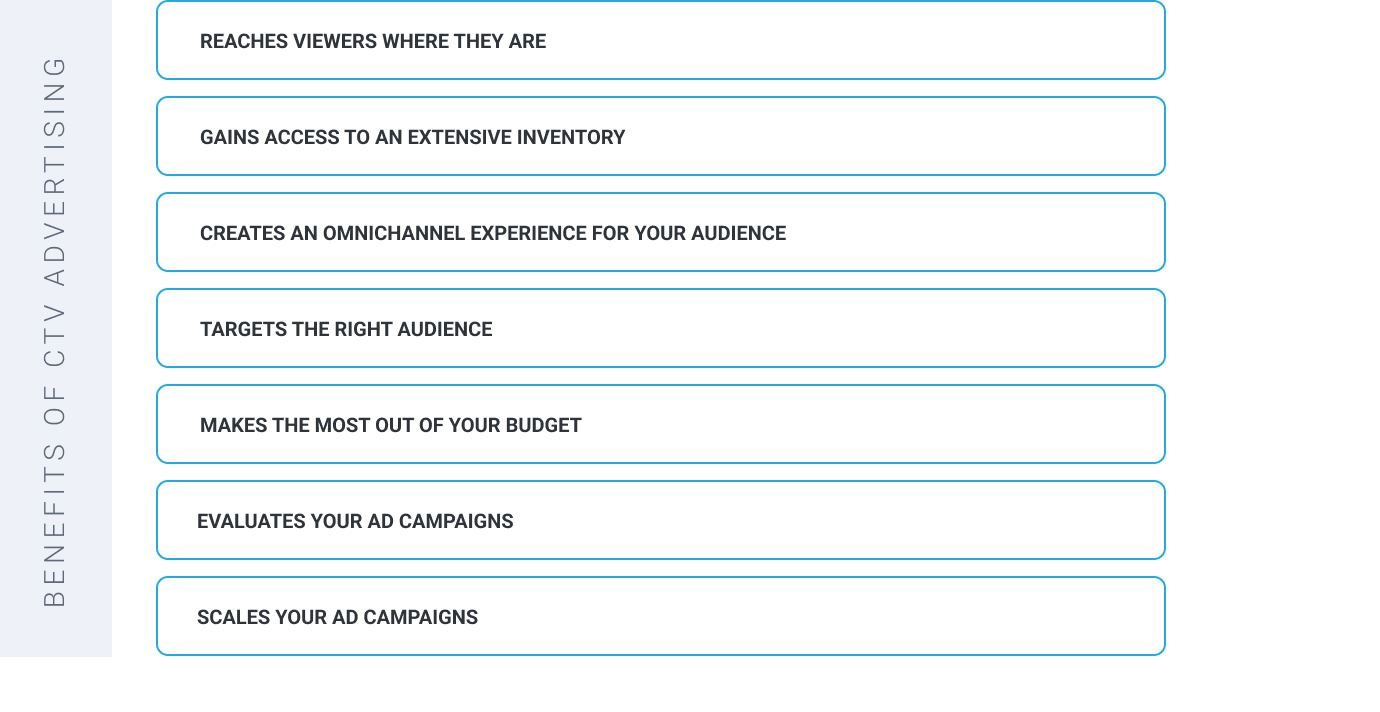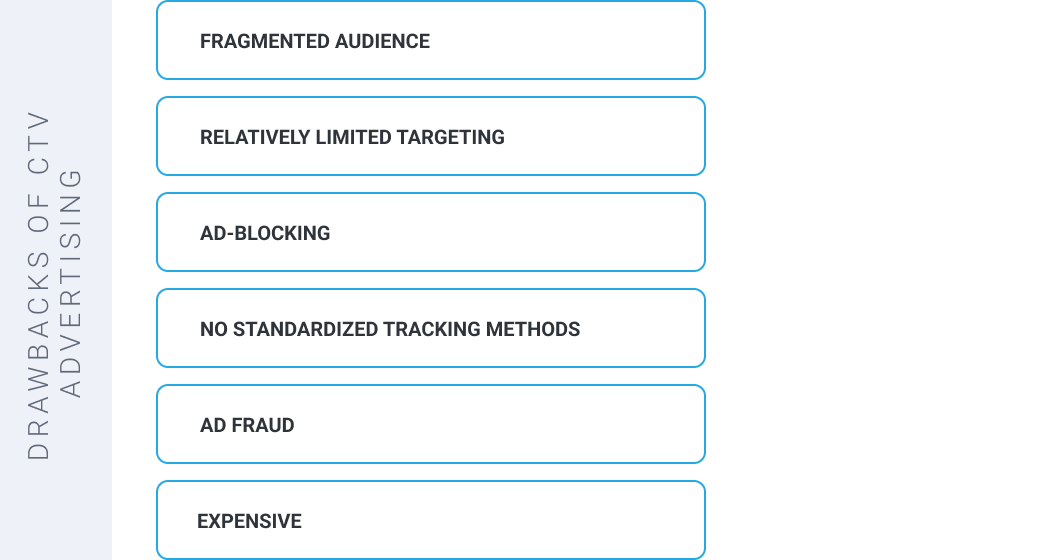OTT vs. CTV: Understanding the Difference and the Opportunities They Present
June 16, 2023
Amazon TV
Marketing
Smart TV
Table of contents
You don’t need statistics or research to tell you that cable TV is dying. You’re most likely witnessing its slow death firsthand. More and more people have become cord-cutters (people who have canceled their cable TV subscriptions) as video streaming continues to disrupt our old TV viewing habits.
Savvy business leaders are quick to turn this trend into an opportunity. Enterprises are not only launching streaming platforms, but they’re also incorporating CTV advertising into their business strategies early on. It’s time to familiarize yourself with these concepts and learn how each can support your business model.
OTT vs. CTV: What do they mean?
People sometimes use OTT and CTV interchangeably. Although these terms are related, they actually mean different things.
What is OTT?
Short for “over-the-top,” OTT refers to a method of delivering film and TV content via the Internet, allowing viewers to bypass traditional cable, broadcast, and satellite TV providers. Some of the most popular OTT platforms are Netflix, Amazon Prime, and HBO Max.
OTT content is accessible via mobile devices, personal computers, and connected TVs.
What is CTV?
A connected TV (CTV) is one of the devices that enables access to OTT content. It’s basically a television that connects to the Internet. Smart TVs are an example of a CTV. You can also turn regular televisions into CTVs by hooking them up to a set-top box, a TV stick, or a gaming console (think Amazon Fire TV Stick, Roku devices, and PlayStation).
What is the difference between OTT and CTV?
Put simply, OTT is the delivery method for streaming content across devices, while CTV is one of the devices that make this delivery possible. As you can see, they are two different things, but they work together to bring you a convenient video-viewing experience.
Understanding these basic terms will help you understand and appreciate what CTV advertising has to offer.

The growing popularity of CTV advertising
Matthew White, Quantcast Vice President of Sales, EMEA (Europe, Middle East, and Africa regions), likened the promise of CTV in 2023 to that of social media in the mid-2000s. In Europe alone, CTV advertising spending grew by 56% in 2021 and is expected to grow by 35% by the end of 2023.
Interested in a piece of this pie? Let’s explore further.
What is CTV advertising?
Connected TV advertising delivers digital ads via Internet-connected television. These ads take the form of display banners, pop-up ads, video commercials, and interactive media.
How does CTV advertising differ from OTT advertising?
CTV advertising is exclusively delivered via Internet-connected television, while OTT advertising covers all the devices that stream OTT content, including CTVs, smartphones, tablets, laptops, and desktop computers. For instance, the advertisements you see while viewing YouTube videos on your mobile device are OTT ads.
Just how popular is CTV advertising?
A 2022 survey from Leichtman Research Group, Inc. (LRG) revealed that of almost two-thousand households in the US with a TV, 87% had at least one CTV, compared to only 69% in 2017 and 38% in 2012. It also showed that 46% of adults watch videos on a CTV daily, an increase from 25% in 2017 to only 4% in 2012. The numbers are bound to increase in the decades to come — the technology is even more popular among young people aged 18-34, with 62% of them streaming videos on a CTV daily.
Hitesh Bhatt, the CTV/OTT Director for PubMatic (EMEA region), sees major content creators prioritizing direct-to-consumer platforms over traditional channels in the long term. This means streaming platforms will attract more viewers and, eventually, a greater proportion of ad spending.
Brands are not blind to these opportunities. The Connected TV Trends, 2022-23 by AppsFlyer survey revealed some very compelling numbers:
- 98% of brands expect CTV advertising is expected to overtake mobile advertising, with one in four predicting this outcome in the next two to three years.
- 86% of consumers have no problem seeing ads on CTV (they will continue watching the videos), particularly those they find relevant. Half of the viewers in North America even downloaded mobile apps that were advertised on CTV.
By now, you’re probably already convinced that CTV advertising is a growing trend. The next section will seal the deal if you’re still on the fence about whether CTC advertising is for you.
Benefits of CTV advertising
Why exactly are brands placing so much faith in CTV advertising? We’ll answer that question by laying out its benefits.

Reaches viewers where they are
There talks of the death of traditional TV. People still watch TV, but not like they used to. They no longer rely on major cable and broadcasting companies to deliver their daily dose of news and entertainment. People in the US will be spending more time streaming video than watching traditional TV in 2024.
Advertisers need to reach people where they are. And for many, that’s on CTV. As mentioned above, 46% of adults already view daily videos via CTV. Therefore, a big benefit of CTV advertising is reaching people where they consume streaming video.
Gains access to an extensive inventory
Major players like Netflix, Disney+, Amazon, and YouTube TV are keeping up with the increasing popularity of CTV advertising. This means an extensive array of premium CTV advertising inventory or advertising slots will be out for the taking. Advertisers can easily access this inventory via demand-side platforms (DSPs), a type of software that automates the purchase of ad spaces.
Creates an omnichannel experience for your audience
Today’s consumers access media using many different platforms and devices. Smart marketers take advantage of this by creating omnichannel experiences that follow their audience across devices. You may have experienced googling a product, then later encountering ads for it while scrolling Facebook on your mobile device, reading emails on your laptop, and streaming YouTube on CTV. Before you know it, you actually purchase an advertised product. Adding CTV advertising to your existing channels increases the chance of making a sale.
Advertising across channels can be a complex process. Fortunately, automated DSs tools can simplify it for you.
Targets the right audience
It’s not enough that ads get eyeballs; marketers need to be sure they get the right eyeballs on their ads. Fortunately, CTV advertising offers sophisticated audience targeting. This means advertisers no longer have to rely solely on standard geographic and demographic targeting. You can program CTV campaign to target your audience according to any of the following parameters:
- Dayparting (targets people who watch at specific times on specific days of the week).
- Retargeting (targets people who’ve already interacted with your brand).
- Content category (audiences who consume news, lifestyle, or sports).
- Content type (audiences who consume movies, TV shows, or vlogs).
As mentioned above, CTV viewers don’t really find ads disruptive. Safe to say, targeted advertising has a lot to do with this; it shows ads to people most likely to be interested in the advertised product.
Makes the most out of your budget
Because you're showing your advertisements to targeted audience segments (i.e., people most likely to purchase your product), you’re more likely to see a return on your ad spending. CTV advertising also lets you track audience response and adjust your ad copy and placement accordingly. This greatly reduces wasted impressions.
Gone are the days when TV advertising was too prohibitive, limiting the opportunity only to big players. Thanks to cost-effective CTV advertising, you can expand your business’s reach via television, which is now within the budget of smaller businesses.
Evaluates your ad campaigns
You need accurate attribution tracking to ensure you’re not wasting ad spend on ineffective campaigns. That is, you need to identify the marketing channels and traffic sources that bring in profits. Fortunately, CTV marketing enables detailed reporting and measurement for key metrics, including purchase attribution, website visits, and brand lift (the ad campaign’s impact on people’s perception of your brand).
Scales your ad campaigns
Because CTV advertising is cost-effective, you can scale your ad campaigns faster. Budget-friendly ad placement, extensive inventory, and effective reporting enable you to flood target audience segments with ads that double down on your messaging, boost engagement, increase conversions, and boost revenue.
CTV advertising comes with benefits serious business leaders simply shouldn’t miss out on. But it also has its challenges.
Drawbacks of CTV advertising

The popularity of CTV advertising has not made it immune to challenges. Here are some drawbacks to expect:
- Fragmented audience. Users access CTV content using many different gadgets. This complicates decisions about how to reach your audience.
- Relatively limited targeting. Although CTV advertising comes with sophisticated audience segmentation, its targeting abilities are still limited compared to other types of digital advertising.
- Ad-blocking. You’ll have to contend with ad blockers that make it virtually impossible to reach certain segments of the market.
- No standardized tracking methods. Although CTV advertising offers accurate attribution measurement, you might still grapple with inconsistent tracking standards across platforms and devices.
- Ad fraud. CTV advertising could expose you to fraudulent practices, such as fake impressions and clicks. You’re especially at risk if you use DSP platforms.
- Expensive. Although more affordable than traditional TV, CTV advertising is still quite costly compared to other digital ads.
With the right balance, you can effectively navigate these challenges and fully embrace the benefits of CTV advertising.
CTV advertising is very promising. But don’t just jump right in. You first need to prepare a strategy that answers the following questions:
- Who do I want to reach?
- What am I trying to achieve? Am I aiming for brand awareness or for people to take a specific action? What specific action do I want people to take?
- What change of perspective do I want to happen?
- How does this CTV campaign fit into my overall marketing strategy?
- What tools do I need to execute this plan?
Your answers to these questions will shape the kind of audience segments, platforms, and content types you choose.
Conclusion
OTT and CTV content are fast taking over as more and more people cut the cord. And this increasing popularity brings enormous CTV advertising opportunities that business leaders simply can’t afford to miss.
Having discussed the distinctions between OTT and CTV and explored key features of OTT platforms, the time to act is now. So let experts at Perfsol, a video streaming app development company, help you apply this knowledge to your strategy to successfully launch your streaming service. Contact us today!
Author
CTO
I am passionate about technologies. Adore solving challenges of our customers: going under the tech problem and trying to deal with a reason rather than a symptom. I do believe that is why our clients choose Perfsol.
FAQ
What is the difference between OTT and CTV in the context of video streaming?
OTT, or over-the-top, refers to the method of delivering film and TV content over the Internet, bypassing traditional TV providers, while CTV, or connected TV, refers to Internet-connected televisions that enable access to OTT content. While OTT is the delivery method, CTV is the device facilitating this delivery.
How does CTV advertising differentiate from OTT advertising, and why is it gaining popularity?
CTV advertising is solely delivered on Internet-connected TVs, while OTT advertising covers all devices streaming OTT content. CTV advertising has witnessed significant growth, with brands leveraging its precise targeting capabilities and access to varied inventory, leading to increased viewer engagement and ad effectiveness.
What are the benefits of CTV advertising for businesses?
CTV advertising offers benefits like reaching audiences where they consume content, accessing vast premium inventory, creating omnichannel experiences, targeted advertising for specific audience segments, optimizing ad spend with accurate tracking, and scaling campaigns for increased reach and impact, making it a cost-effective and efficient marketing channel.